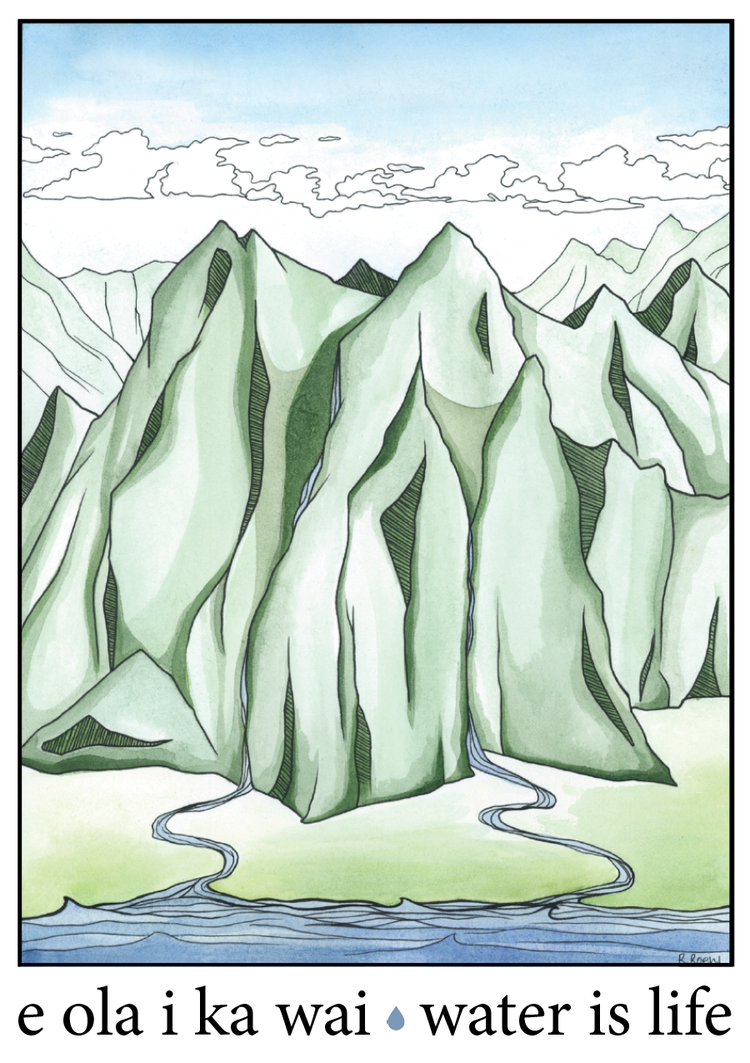E ola i ka wai - Water is life
Without water there is no life. To better understand the value of water, it is important to understand where Hawaiʻi’s water stems from and how it is connected to everything.
WATER CYCLE:
Mauka to makai and back
MA KAI//
Water is evaporated from the ocean, condenses into clouds, and builds up until it becomes rain. Rainwater that does not seep through soil and rock into underground aquifers stays on the surface and forms streams in the valleys of mountains.
MA UKA//
As the streams run down the slopes and reach lower elevations, streamflow recharges the groundwater supply and freshwater is captured for drinking, traditional practices, and subsistence agriculture.
MA KAI//
The water that remains, flows down to the ocean where it meets the seawater, creating muliwai or estuaries along the coast. These muliwai are important to native ecosystems—often serving as nursery areas for marine and aquatic native species such as āholehole and ʻoʻopu.
Today, this cycle is interrupted for many reasons. With major loss of native forests to invasive species and development, there is less precipitation, less water capture, and less recharge of the islands’ aquifers. This also means less water in the streams. Add in the century old practice of stream diversions once used for large scale commercial agriculture and the amount of water in the streams and what reaches the ocean is greatly reduced.
Food security: Grown here not flown here
Photo: Nate Yuen
Pre-contact, Hawaiian communities flourished with agriculture centered around taro, a staple a crop that grew best with an abundant supply of of cool flowing freshwater. Taro is also a central part in the Native Hawaiian creation story. Traditionally, fields of taro were irrigated by stream systems sustainability, with water returning back into the stream of origin after use. When corporations began diverting water for sugar crops, traditional food systems suffered.
Today, Hawaiʻi imports 90% of its food and exports 80% of the crops grown in the islands. Small scale diversified agriculture for local food production, including taro, is making a comeback throughout the archipelago. But two important parts are missing—a reliable source of freshwater and farmable land. Current stream diversions on at least Maui and Kauaʻi divert the majority of water in their streams, interrupting mauka to makai flow and keeping residents along streams from growing kalo and growing food for their families. Much of the Important Agricultural Lands in the islands are held by big former-sugar-plantation-now-landowners. For example, A&B (now Mahi Pono) holds 23,000 acres of Important Ag Lands.
Food security means food grown in Hawaiʻi for Hawaiʻi. It is about supporting the return of traditional agriculture and supporting local farmers in modern diversified agriculture. It is more than just GMO vs. non-GMO. Hawaiʻi needs to have access to clean, flowing freshwater and agricultural lands that can be cultivated for food for our families and communities. Food security does not have to come at the cost of public trust waters and the ecosystems that depend on them. If shared properly, there is enough water for all.
Let nature take its course
Left undeterred, freshwater streams will flow into the ocean, mix with the salt water, and create brackish areas in nearshore waters—muliwai.
Muliwai: Growth not waste
Muliwai are amongst the most productive ecosystems on Earth and serve as essential nursery habitat for young native species. These brackish water areas help filter streams before they empty fully into the ocean, capturing organic matter and creating nutrient rich areas for species to feed within. Many native species, like ʻoʻopu and hihiwai, also rely on these brackish water areas to help their young find its way back to the freshwater streams.
Stream diversions reduce the amount of freshwater that reaches the ocean, making it harder for the young native species to find the brackish water and ultimately the stream mouth to make their way back upstream.
Native stream life: Go with the flow
ʻOʻOPU//
There are five species of ʻoʻopu in Hawaiʻi, four of which are endemic and found nowhere else in the world. ʻOʻopu are amphidromous meaning they migrate twice in their life—they lay thousands of eggs in crevices in streams and once they hatch the larvae are washed out into the ocean where they live for the first 3-6 months of their lives. Dependent on freshwater cues, the young will swim back toward the shore where some species will stay here in the muliwai for the remainder of their life while others will continue upstream, capable of climbing up rocks and waterfalls.
HIHIWAI//
Hihiwai are endemic freshwater snails—there are two species in Hawaiʻi. Like ʻoʻopu they are also amphidromous. They attached hundreds of eggs to rocks, or even each other’s shells, and once hatched the larvae wash out to the ocean where they can spend up to a year before returning to a stream. The juvenile can then be seen marching single file up the stream usually during the summer. The new recruits will migrate upstream until they find a suitable place to spend their adult lives.
ʻOPAE//
ʻOpae are endemic freshwater shrimp that feed on small plant and animal materials. There are two species in Hawaiʻi—ʻopae kuahiwi and ʻopae oehaʻa. ʻOpae kuahiwi are found in higher sections of the stream in fast flowing waters and are known to be able to climb tall waterfalls. ʻOpae oehaʻa are found lower in the stream often in slower flowing waters and nutrient rich muliwai.
Stream diversions also make it more difficult, if not impossible, for many of the native stream species to migrate back up stream. This disruption in the species lifecycle, in addition to other factors, reduces their reproduction and ultimately their species abundance.



